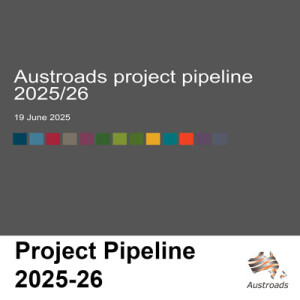Episodes

Tuesday Sep 16, 2025
Austroads Cycling and Micromobility Planning Tool
Tuesday Sep 16, 2025
Tuesday Sep 16, 2025
This practical webinar unpacks the new cycling and micromobility planning tools from Austroads' recent report ‘Improving Austroads Guidance for Cycling and Micromobility Planning’ (AP-R724-25). This session is designed for transport practitioners looking to apply best practice principles in real-world projects.
Presenters explore the updated Cycling Level of Service (CLoS) tool, the All Ages and Abilities Facility Selection tool, and discuss practical approaches to road space reallocation, intersection design, and micromobility integration. Whether you're working in planning, design, or delivery, this webinar will help you navigate the tools and apply them confidently to uplift cycling outcomes across your network.

Wednesday Sep 03, 2025
Sustainability Review of Austroads Technical Specifications and Test Methods
Wednesday Sep 03, 2025
Wednesday Sep 03, 2025
Governments around the world have set sustainability targets in areas such as greenhouse gas emissions , climate resilience and the circular economy. Meeting these sustainability targets will challenge Austroads member agencies and the infrastructure sector to identify and adopt new and changed approaches.
This webinar presented the findings of the Austroads research report, Sustainability Review of Austroads Technical Specifications and Test Methods. Drawing from lessons learned from preparing the report, presenters explored the research that examined Austroads Technical Specifications to identify specific opportunities for improvement and how to addresses barriers that hinder progress.

Thursday Aug 21, 2025
Austroads' Review of Movement and Place Guidance
Thursday Aug 21, 2025
Thursday Aug 21, 2025
Movement and Place is a cross-cutting planning principle that that recognises streets and roads as both transport corridors and public spaces; supporting the flow of people and goods while also shaping the activity, built form and identity of places.
This webinar introduces the findings of the Austroads research project NEG6384 Movement and Place Guidance, which provides the foundation for updated and more unified Movement and Place content across the Austroads Guide to Traffic Management and related resources.
Through extensive stakeholder consultation and a review of leading national and international frameworks, the project identified gaps in current Austroads guidance. It also revealed the varied maturity levels of implementation across transport agencies in Australia and New Zealand, highlighting a critical opportunity to strengthen consistency, collaboration and innovation.
The report sets out a series of recommendations designed to update and streamline Movement and Place guidance, focusing on:
- Consistency: A shared language and core concepts across Austroads publications.
- Best Practice: Identification of proven tools and frameworks already in use.
- Clarity: Practical direction through case studies and real-world examples.
Whether you’re new to Movement and Place or working to embed it within policy, planning or project delivery, this webinar will help you understand how updated guidance can support more balanced, people-focused transport networks across the region.

Friday Aug 08, 2025
Driving Safety for Two: Study on Correct Seatbelt Use During Pregnancy
Friday Aug 08, 2025
Friday Aug 08, 2025
In this webinar, Sjaan Koppel, winner of the Austroads-sponsored Women in Road Safety Award 2024, presents findings from an Australian study on the importance of correct seatbelt use during pregnancy for maternal and fetal safety in car crashes.
Sjaan discusses practical strategies to improve public health messaging, healthcare guidance, and vehicle design, providing valuable insights for road safety stakeholders and healthcare providers.

Friday Aug 08, 2025
Updating the Standardised Bridge Barrier Design Guidelines
Friday Aug 08, 2025
Friday Aug 08, 2025
Inconsistency in the design of traffic barriers for bridges has been identified as a major issue in current practice throughout Australia and New Zealand. The need for standardised solutions has been recognised by road jurisdictions, consultants, and contractors. Key concerns include the determination of appropriate barrier performance levels, structural design criteria, the lack of standard barrier design details, guidance on retrofitting existing bridge barriers, bridge approach barriers and overpass bridge support protection.
To address this, Austroads commissioned a review of the Austroads Standardised Bridge Barrier Design Report AP-R445-13 1 based on current research, guidance, and standards. The project also aimed to verify compliance of bridge barrier designs and guidelines against the relevant Australian Standards that have been recently updated, and the American Association of Highway and Transportation Officials (AASHTO) Manual for Assessing Safety Hardware (MASH). To achieve this a comprehensive literature review was undertaken, full scale crash testing was conducted and Finite Element Modelling created and calibrated.
This webinar covered:
- The project and updated Austroads Standardised Bridge Barrier Design Guideline
- The crash testing including Finite Element Modelling and full-scale crash test.

Wednesday Aug 06, 2025
Road Manager Operations Capability Framework
Wednesday Aug 06, 2025
Wednesday Aug 06, 2025
The transport sector, particularly in road network operations and management, is experiencing a period of significant and rapid change globally. This disruption is directly affecting how people and industry access, navigate and use transport and road networks. Expectations around transport, travel needs and user behaviour are shifting.
More broadly, these changes are contributing to the growing momentum to improve how we live and work, and how our cities function and evolve. As a result, the capabilities needed to manage and operate transport networks are also changing quickly.
The changes within the sector can be grouped into five key areas:
- network safety
- technological advancements
- environmental sustainability and climate change
- shifting network demands
- evolving customer and stakeholder expectations
In response, Austroads has commissioned the Road Manager Operations Capability Framework, supported by a research report. Together, these outline how road managers can effectively respond to emerging trends in transport operations.
The framework identifies four core capabilities: communication, stakeholder engagement, leadership and change management. It also outlines four operational capabilities: network management, incident and event management, system management, and data and insights. Each capability is supported by a set of skills mapped against a proficiency matrix.
The webinar, presented by Richard Boggon and Thomas D’Arcy, explores the trends shaping the future of road network operations. It also provides a detailed overview of the capability framework, the skills and proficiencies it defines, and how it can be applied and adopted within the sector.

Tuesday Jul 29, 2025
LED Lighting in Existing Road Tunnels: Best Practice Approaches
Tuesday Jul 29, 2025
Tuesday Jul 29, 2025
This webinar provided an overview of the Austroads Report, ‘LED Lighting in Road Tunnels – Best Practice Approaches’ which summarises the process undertaken to explore tunnel lighting upgrades to LED, and provides best practice guidance for tunnel owners and operators considering the transition to more efficient lighting systems.
Many existing tunnels currently use fluorescent or High Pressure Sodium (HPS) lighting, and there is a growing opportunity to replace or retrofit these with more efficient light emitting diode (LED) equivalents. While LED luminaires generally boasts higher efficacy than fluorescent and HPS equivalents, lighting upgrade projects can present major technical and cost challenges.
Drawing on stakeholder consultations and a literature review, this webinar discussed current practices, common challenges, and practical considerations for planning and delivering lighting upgrades. Presenters used local case studies and project experiences to provide recommendations to support informed decision-making throughout the project lifecycle for future projects and also answered attendee questions at the end of the seminar.

Wednesday Jul 23, 2025
Unlocking the Potential of Telematics Analytics Platform for Local Governments
Wednesday Jul 23, 2025
Wednesday Jul 23, 2025
As jurisdictions across Australia and New Zealand increasingly rely on data to improve road safety, transport efficiency, and sustainability, Austroads’ Telematics Analytics Platform (TAP) is at the forefront, providing road agencies data to make better-informed decisions.
Managed by Austroads, TAP provides secure, online access to aggregated and anonymised telematics data from vehicles enrolled in the National Telematics Framework schemes. It offers invaluable insights into vehicle movements, road usage, and infrastructure performance, enabling local agencies to optimise their strategies and operations.
This webinar focused on the benefits of using telematics data for local asset management and transport planning – particularly with regard to restricted access heavy vehicles. Presenters spoke about how local transport managers harness data from TAP to drive improvements in infrastructure management, land use and urban planning, road safety, and transport efficiency.
What was covered:
- What data is included, and what the data represents
- How local road managers are using TAP to enhance road safety, optimise decision-making, and improve road network performance
- Key benefits of integrating telematics data into local transport planning and asset management

Tuesday Jul 08, 2025
eCall: Possible Approaches to Australia and New Zealand
Tuesday Jul 08, 2025
Tuesday Jul 08, 2025
Automatic Crash Notification (ACN) systems, such as eCall, automatically notifies emergency services in the event of a crash, transmitting key data such as the location, time and severity of the incident. The primary purpose of ACN is to aid faster response time to crashes, increasing the likelihood of occupants surviving a crash. While ACN technology is becoming increasingly common in new vehicles and personal devices like smartphones and smartwatches, Australia and New Zealand face challenges in its adoption.
As part of the project, a research report was developed, which provides a summary of the ACN services emerging in Australia and New Zealand, including their operation, benefits, market uptake, and high-level costs to implement. Approaches taken in other countries are also identified, to assess the applicability and potential implications of these approaches to Australia and New Zealand.
In this webinar, the presenters outlined project aims, methodology, key findings from the report and next steps. Drawing from lessons learned from preparing the report, international deployments and local stakeholder feedback, this webinar explored how ACN can be effectively implemented to maximise safety and economic benefits, and highlight key decisions around technology standardisation, investment in emergency response systems, and ensuring equitable access to the technology. Presenters also answered Q&A at the close of the session.

Thursday Jun 19, 2025
Austroads Project Pipeline 2025-26
Thursday Jun 19, 2025
Thursday Jun 19, 2025
Are you looking for an opportunity to work with Austroads to help Australian and New Zealand transport agencies deliver efficient, reliable, and safe mobility to their customers?
This webinar introduced new projects lined up for the 2025-26 financial year. Consultants interested in tendering for Austroads projects will find this session beneficial.
The session covered the Austroads tendering process with presentations from Austroads program managers:
- Ross Guppy, Program Manager Transport Infrastructure
- Michael Nieuwesteeg, Program Manager Road Safety and Design
- Amy Naulls, Program Manager Transport Network Operations
- Joanne Vanselow, Program Manager Vehicles and Technology, and Environment and Sustainability
This webinar was moderated by Paul Davies, General Manager Research, Guidance and Practice.

